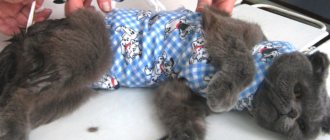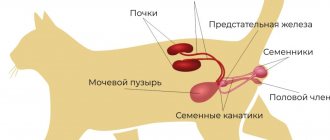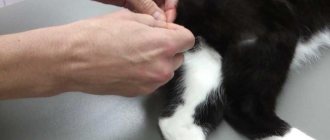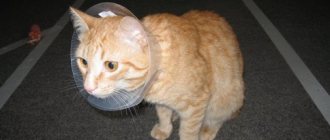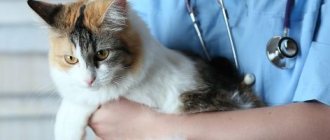Cat owners sometimes have to deal with the fact that their pets need surgery.
. The procedure may be needed to treat a disease or correct a congenital defect that prevents the animal from leading a full life. Also, quite a few domestic cats undergo neutering surgery.
Any surgical intervention is a serious stress for the body and may be accompanied by complications. In order for your cat to recover as quickly as possible, you need to provide her with rest and proper care during the postoperative period. Sometimes veterinary clinics offer owners to leave the animal in the hospital for some time after surgery. But if the cat’s condition allows you to take it home, it is better to do just that, because for a recovering animal, a familiar environment and the care of a loving owner are extremely important.
Typically, after an uneventful operation, special care is required for 10-14 days, although in some cases recovery may take longer.
We will talk about the basic rules for caring for a cat that has recently undergone surgery.
Coming out of anesthesia
Three different types of anesthesia are used for surgery. The cat's condition after sterilization surgery largely depends on what type of anesthesia was used.
- Inhalation (gas) anesthesia. One of the most effective methods of general anesthesia, after which the cat comes to its senses very quickly - almost as soon as the anesthesia mask is removed from its face. It is rarely used due to the high cost and lack of necessary equipment in hospitals.
- Muscle relaxants in combination with epidural anesthesia. This type of anesthesia is easily tolerated by the cat, and complete recovery from it takes a maximum of 8 hours. However, there are risks of postoperative complications, during which sensitivity and motor activity of the hind limbs are impaired. Restoring everything can take up to 2 days.
- Muscle relaxants with analgesics are used most often, but recovery from such anesthesia can take from 6 hours to a day.
The behavior of a cat after a sterilization operation at the moment of recovery from anesthesia can be the most unexpected:
- impaired coordination of movement (shaky and unstable gait);
- inappropriate behavior - from passive indifference to everything to open aggression;
- desire to run somewhere;
- inadequate reaction to surrounding people and what is happening around;
- disorientation;
- a clear desire to hide somewhere or hide in a dark corner;
- inexplicable meowing;
- vomit;
- uncontrolled urination.
Castration of cats
Castration of a cat is one of the simplest, fastest, and most uncomplicated surgical operations. During surgery, general anesthesia is used for pain relief. Some veterinarians practice combined anesthesia (general, local), using short-acting drugs that reduce the sensitivity of animals for a certain period. In addition to injection drugs, special gas and ethers are used.
After administering the drugs, it takes some time for the cat to fall asleep. Time intervals depend on the individual physiological parameters of the mustachioed pets’ body.
The anesthesia drug and dosage are selected by the veterinarian taking into account the individual characteristics of the body, age, and weight of your cat.
After the injection, before putting the cat into a narcotic sleep, the pet may feel sick and vomit. This is normal. This is how the animal’s body reacts to the administration of the drug. Therefore, before castration, veterinarians recommend keeping your pet on a starvation diet .
Before the operation, the surgeon examines the animal, measures the temperature, heart rate, and determines the cat’s weight. Castration is carried out only if there are no contraindications and all vital signs are normal. The duration of castration ranges from 15-20 minutes to an hour. During the operation, the veterinarian surgeon makes thin incisions and through them removes the testes that produce sex hormones.
General condition and behavior of the cat in the first days after surgery
How a cat feels after sterilization depends on:
- on the age of the animal when the operation was performed;
- whether the surgical intervention was emergency or planned;
- what type of anesthesia was used.
In the first hours, post-anesthesia hypothermia may be observed due to disturbances in temperature metabolism, manifested by coldness of the extremities. At home, it is advisable to place the cat on a slightly warm heating pad, covering it with something.
After surgery, the cat will be wearing a postoperative bandage (blanket) or protective collar so that the animal does not have access to the suture and wound. When the pet comes to its senses after anesthesia, it will try in every possible way to tear off all these devices. It is enough to ensure that the animal does not injure itself. The animal will get used to everything in a day or two.
After sterilization, a cat may exhibit aggressive behavior. This is due to an increased reaction to environmental noises and numerous people around as the senses return to full function. It is enough to place the cat in an isolated room or lock it in a carrier for a while.
After recovering from anesthesia, the animal may feel pain. It is recommended to inject or give an anesthetic internally. The main signs of postoperative pain in a cat:
- increased aggression during any attempts to contact her (for example, pick her up);
- dilated pupils;
- immobility in one position (mainly on the stomach, legs tucked under you);
- concentrated gaze at one point;
- complete refusal of food.
Complications after anesthesia
After operations using general anesthesia, in some cases, veterinarians recommend leaving the cat in the clinic for a while to monitor the animal’s condition. In case of possible complications, the surgeon who performed the operation will provide qualified assistance.
Possible complications after anesthesia and castration:
- heartbeat disturbance;
- depression of the respiratory center;
- a sharp drop in overall temperature;
- muscle cramps, spasms;
- disorientation in space;
- inappropriate behavior;
- bleeding of postoperative sutures.
If the veterinarian deems it necessary, he will advise leaving the cat in the clinic for several days until the animal’s condition is completely normalized.
Therefore, we recommend leaving the veterinary clinic after castration or performing any other surgical operations only when the veterinarian says so and no complications are observed. Be sure to ask your veterinarian about how long it will take for your cat to recover from anesthesia, as well as how to properly care for your pet during the postoperative period.
Natural bowel movements, appetite and thirst
It is necessary to ensure that the cat goes to the toilet on the first day after surgery. Frequent trips to the toilet should also alert you, as should the complete absence of bladder and bowel movements. In case of reflex postoperative constipation (no bowel movement for up to 3 days), you will need to give a laxative, after consulting with your veterinarian.
Normal active appetite and thirst should return on the second or third day. By this time, the cat is already showing a normal interest in food and drink, so it is already asking for food and drinking on its own according to its needs. Important: it is not recommended for a cat to eat a lot after sterilization. What to do if he asks to feed often? It is enough to reduce food portions. Neutered cats are prone to obesity due to increased appetite due to hormonal changes, so their diet and feeding regimen will have to be monitored more carefully than before surgery.
What signs should alert the owner
The cat lies for a LONG time and does not try to get up - the help of a veterinarian is required
Even though castration is a simple operation and often does not harm the animal, sometimes things can go wrong. The entire time the pet is recovering from anesthesia, it must be closely monitored in order to notice alarming symptoms in time.
A veterinarian's help may be needed if:
- lies motionless for and does not even try to get up;
- the animal has a rapid heartbeat and rapid breathing ;
- You can determine the cat’s condition using a regular flashlight: if you direct a stream of light into his eye, the pupil should narrow ; if this does not happen, it’s time to call a doctor ;
- has not gone to the toilet for a day or more or makes a plaintive meow while urinating.
If the owner notices at least one of these symptoms, he should immediately contact a veterinarian, preferably the same one who performed the operation, because only he knows what type of drug and in what dosage he administered to the cat.
Suture removal and general recovery
Typically, during sterilization, intradermal sutures are placed that do not need to be removed. External sutures are removed on days 7-10, but no later than the 12th, so as not to allow the suture material to grow into the skin and surrounding tissues. Throughout the healing period of the postoperative wound, the suture should be clean, dry, and without signs of inflammation.
How long it takes for a cat to recover from neutering will depend on the environment she is in after surgery, as well as her overall health. Young and healthy cats recover faster than older cats burdened with additional diseases. Usually, by the 5-7th day, only the presence of a postoperative collar or blanket reminds of the operation, and otherwise the animal should already lead its normal lifestyle. Full recovery of the cat after sterilization is observed after 3-4 weeks.
When to drink?
Water can be offered as soon as the cat wakes up. At first, a few drops will be enough to moisten the oral mucosa. It is important to remember that you should not place a bowl of water in front of your cat: it may choke if it falls into it with its face. In addition, she will not be able to drink normally from a bowl until her swallowing reflex is restored.
How long does it take?
How long it takes for an animal to wake up depends on its age and body characteristics. Typically, recovery from anesthesia is observed four hours after surgery. According to experienced breeders, pets that are very active wake up earlier. Already 60 minutes after castration they begin to get up or try to climb onto the bed. On animals that have a phlegmatic temperament, anesthesia lasts longer. The pet often wakes up after 6 hours, but the effect of anesthesia sometimes lasts up to 24 hours.
Sterilization and castration: what is it and why are they needed?
Technically, spaying and neutering are two completely different procedures. During castration surgery, internal organs responsible for the production of sex hormones are removed from animals:
- in a cat - the ovaries (sometimes the uterus is also cut out);
- in cats - testes.
After this, the pets lose all signs of sexual behavior and the ability to reproduce.
After castration the cat becomes calm
The sterilization operation involves less drastic measures, consisting only of ligation (cauterization, cutting, etc.) of the fallopian tubes in females and the spermatic cords in males. Sexual activity with all the ensuing unpleasant consequences (the cat is in heat, marking territory, restlessness, screaming at night, etc.) is preserved. Only the opportunity to produce offspring is lost.
In practice, animals are most often subjected to castration, since as a result of this procedure, pets do not experience severe stress associated with hormonal storms, get sick less often and live longer, and also cause much less anxiety to their owners.
There are many good reasons to spay or neuter animals.
Like any surgical intervention, these operations pose a certain danger for pets due to possible postoperative complications (formation of adhesions, infection, accumulation of fluid in the abdominal cavity, etc.), as well as individual reactions to anesthesia (anesthesia).
Video: the difference between castration and sterilization
How long does the recovery period last and what does it depend on?
The rehabilitation period for pets under favorable circumstances usually does not exceed 1.5–2 weeks . The following factors can directly influence the recovery process:
- Age. The older the cat, the more difficult it will be for surgery.
- Pedigree. The more purebred the cat, the longer it will take to recover from surgery.
- Food quality.
However, complete rehabilitation may take a month or even longer.
It is better not to sterilize or castrate older animals unless absolutely necessary, as they may not survive it.
Seam processing
Until the stitches have healed, the cat should be temporarily isolated from other animals and children, and, if possible, not allowed outside. In the first case, it will be possible to avoid damage to the seams from outdoor games, in the second - their contamination and, as a result, infection. It is also not recommended to wet the seams with water.
During the recovery period, your cat may require dressings. They can be carried out at home. Bandages must be sterile. Before applying the bandage, you need to treat the seam with an antiseptic, which will be prescribed to you by your veterinarian. Most often this is an aqueous solution of chlorhexidine. It is highly undesirable to use iodine and brilliant green for processing.
How does anesthesia affect a cat?
The owner should not worry if the pet’s tongue falls out of the pet’s mouth in this condition.
When animals that have been castrated are under anesthesia, they often sleep with their eyes open, which greatly disturbs their owners. However, there is no need to panic. The owner needs to examine the pet to understand that everything is fine with it. First of all, you will need to arm yourself with a flashlight and shine it on the pupil. If it narrows, there is no need to worry. You need to pay attention to the limbs and tail of your pet. If he moves them, then there is no reason to panic. In addition, the cat should breathe intermittently and frequently. Often, a cat may have different pupils, which is also considered normal. Veterinarians from the Zoovet clinic note that if a cat has vomited, stuck out its tongue in a dream and is bothered by convulsions, you should not worry either. Such signs are considered a normal physiological reaction of the body after general anesthesia.

